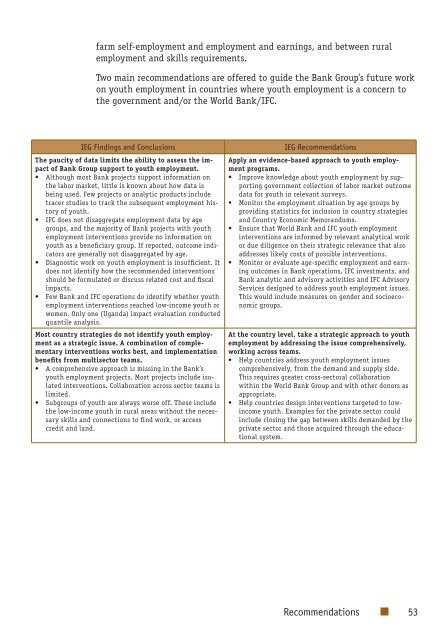Youth Employment Programs - Independent Evaluation Group
Youth Employment Programs - Independent Evaluation Group
Youth Employment Programs - Independent Evaluation Group
Create successful ePaper yourself
Turn your PDF publications into a flip-book with our unique Google optimized e-Paper software.
farm self-employment and employment and earnings, and between ruralemployment and skills requirements.Two main recommendations are offered to guide the Bank <strong>Group</strong>’s future workon youth employment in countries where youth employment is a concern tothe government and/or the World Bank/IFC.IEG Findings and ConclusionsThe paucity of data limits the ability to assess the impactof Bank <strong>Group</strong> support to youth employment.• Although most Bank projects support information onthe labor market, little is known about how data isbeing used. Few projects or analytic products includetracer studies to track the subsequent employment historyof youth.• IFC does not disaggregate employment data by agegroups, and the majority of Bank projects with youthemployment interventions provide no information onyouth as a beneficiary group. If reported, outcome indicatorsare generally not disaggregated by age.• Diagnostic work on youth employment is insufficient. Itdoes not identify how the recommended interventionsshould be formulated or discuss related cost and fiscalimpacts.• Few Bank and IFC operations do identify whether youthemployment interventions reached low-income youth orwomen. Only one (Uganda) impact evaluation conductedquantile analysis.Most country strategies do not identify youth employmentas a strategic issue. A combination of complementaryinterventions works best, and implementationbenefits from multisector teams.• A comprehensive approach is missing in the Bank’syouth employment projects. Most projects include isolatedinterventions. Collaboration across sector teams islimited.• Subgroups of youth are always worse off. These includethe low-income youth in rural areas without the necessaryskills and connections to find work, or accesscredit and land.IEG RecommendationsApply an evidence-based approach to youth employmentprograms.• Improve knowledge about youth employment by supportinggovernment collection of labor market outcomedata for youth in relevant surveys.• Monitor the employment situation by age groups byproviding statistics for inclusion in country strategiesand Country Economic Memorandums.• Ensure that World Bank and IFC youth employmentinterventions are informed by relevant analytical workor due diligence on their strategic relevance that alsoaddresses likely costs of possible interventions.• Monitor or evaluate age-specific employment and earningoutcomes in Bank operations, IFC investments, andBank analytic and advisory activities and IFC AdvisoryServices designed to address youth employment issues.This would include measures on gender and socioeconomicgroups.At the country level, take a strategic approach to youthemployment by addressing the issue comprehensively,working across teams.• Help countries address youth employment issuescomprehensively, from the demand and supply side.This requires greater cross-sectoral collaborationwithin the World Bank <strong>Group</strong> and with other donors asappropriate.• Help countries design interventions targeted to lowincomeyouth. Examples for the private sector couldinclude closing the gap between skills demanded by theprivate sector and those acquired through the educationalsystem.Recommendations 53
















